Nature & Environment 2004
Wildlife and plants
The UN Convention on Biological Diversity obligates Member States to protect nature. Essential in this regard, is the conservation of the habitats of wildlife and plant species. The objective is to halt the decline in biodiversity by 2010.
Denmark is the threshold between the Atlantic region and the continent, between the saline North Sea and the brackish waters of the Baltic Sea, and although Denmark is a small country, our climate is changeable, with considerable regional differences. Therefore, Denmark is the natural home for a large number of plants and animals - around 30,000 species in all.
Red-listed species in Denmark
In 2004, the National Environmental Research Institute updated Denmark's Red List of threatened species, now with a total of 2,465 species of Danish fungi, insects, spiders, birds, etc. The update revealed that one in every four species is evaluated as having disappeared or as being threatened to a greater or lesser extent.
To red list is to evaluate which plant and wildlife species are at risk of extinction. Plant and wildlife species die out (or come into existence) as part of the Earth's natural processes. However, throughout the last century increased human activity has led to greater risk of extinction for certain species.
In the 2004 evaluation, specialists found 678 out of 2,465, or 27 per cent of Denmark's species to have either disappeared or to be threatened to a greater or lesser extent. 66 species have disappeared from Denmark since 1850, whereas 93 are evaluated as critically endangered. A total of 1,455 species are considered free from threat and for the last 196 species data is insufficient to make an evaluation.
The purpose of red listing is partly to provide a basis for assessing developments in natural biodiversity in Denmark, and partly to honour Denmark's international commitments under the UN Convention on Biological Diversity, which Denmark ratified in 1994. Denmark has the following national sub-targets under the UN Convention on Biological Diversity:
- to create awareness about disappeared or threatened species
- to create a foundation for making priorities in nature monitoring in Denmark
- to create a foundation for nature management and nature protection work, nationally and internationally, and
- to fulfil Denmark's international commitments under the UN Convention on Biological Diversity through routine publication of red lists of indigenous, disappeared and threatened species of plants and wildlife in Denmark.
Status of threatened species
| Group | Number of species |
Critically endangered (CR) |
Moderately endangered (EN) |
Vulnerable (VU) |
Number of threatened species |
| Birds | 209 | 6 | 8 | 7 | 46 |
| Reptiles | 8 | 0 | 0 | 0 | 1 |
| Amphibians | 15 | 1 | 0 | 0 | 3 |
| Insects, spiders, etc.: | |||||
| Carabidae | 182 | 3 | 10 | 23 | 62 |
| Odonata | 54 | 2 | 1 | 3 | 17 |
| Lucanidae, Trogidae, Geotrupidae, Scarabaeidae | 92 | 10 | 12 | 4 | 52 |
| Cerambycidae | 73 | 2 | 4 | 9 | 26 |
| Curculionidae, Brachycerinae | 110 | 1 | 3 | 5 | 13 |
| Brentidae | 83 | 5 | 2 | 5 | 15 |
| Lepidoptera: Rhopalocera | 98 | 7 | 10 | 10 | 43 |
| Diptera: Syrphidae | 280 | 4 | 15 | 34 | 82 |
| Diptera: Asilidae | 30 | 5 | 2 | 3 | 13 |
| Orthoptera | 33 | 4 | 0 | 1 | 9 |
| Arachnida: Araneae | 244 | 0 | 3 | 2 | 8 |
| Crustacea: Branchiopoda: Notostraca; | 2 | 0 | 0 | 1 | 1 |
| Heteroptera: Gerromorpha & Nepomorpha | 59 | 0 | 1 | 1 | 3 |
| Tenebrionidae | 45 | 1 | 4 | 3 | 15 |
| Elateridae, Eucnemidae | 76 | 2 | 2 | 9 | 20 |
| Nemonychidae | 1 | 0 | 0 | 0 | 0 |
| Anthribidae | 11 | 0 | 1 | 2 | 3 |
| Attelabidae | 18 | 0 | 0 | 1 | 1 |
| Curculionidae, Curculioninae, Dryophthorinae, Cossoninae | 20 | 0 | 3 | 1 | 7 |
| Curculionidae, Scolytinae | 62 | 0 | 4 | 4 | 10 |
| Crustacea: Branchiopoda: Laevicaudata and Spinicaudata | 1 | 0 | 0 | 0 | 0 |
| Crustacea, Branchiopoda: Anostraca | 2 | 0 | 0 | 0 | 0 |
| Orchids | 46 | 3 | 8 | 7 | 28 |
| Fungi: | |||||
| Clavarioid fungi and Ramarias | 6 | 0 | 0 | 0 | 1 |
| Hydnaceous fungi | 22 | 9 | 6 | 4 | 20 |
| Polypores | 147 | 8 | 16 | 7 | 41 |
| Corticoid fungi | 65 | 0 | 1 | 6 | 8 |
| Agarics | 146 | 13 | 34 | 15 | 77 |
| Russula and Lactarius | 185 | 6 | 20 | 23 | 55 |
| Inoperculate discomycetes | 37 | 0 | 0 | 0 | 0 |
| Hydnaceous, (Hericiales pp. Gomphales pp.) | 5 | 1 | 1 | 1 | 5 |
| Total | 2465 | 93 | 171 | 190 | 454 |
Source: National Environmental Research Institute (NERI)
11 BIRDS IN THE OPEN COUNTRYSIDE
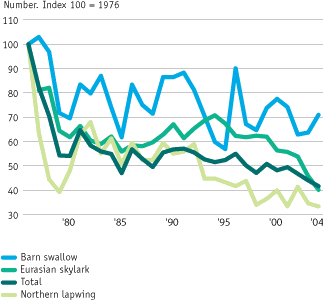
Danish Ornithological Association's bird point source count
The graph shows the changes in the total population of northern lapwing, barn swallow, and Eurasian skylark from 1976 to 2004. The overall development also includes populations of corn bunting and grey partridge.
Since the 1970s, the populations of skylark and lapwing have halved. The primary reason is increased drainage by agriculture and, in general, more intense exploitation of grass areas. The increased use of pesticides by agriculture eradicates the plants and insects that birds living on agricultural land depend on. The Eurasian skylark, Denmark's third most common species of bird, has adapted to the arable land to some extent. The positive, upward trend in population growth of the skylark from the mid 1980s, however, has peaked. This species is now in decline throughout most of Europe, and mostly so in west-European countries.
The breeding population of swallow fluctuates considerably from year to year. These fluctuations depend on e.g. weather conditions during migration and at the birds' winter habitat. In general, the number of breeding birds has fallen by about 25 per cent since the 1970s. This is linked to a fewer number of farms with livestock and poorer access to barns and outhouses, so that it is difficult for the swallows to find suitable nesting sites. The barn swallow is in decline throughout almost all Europe.
For the 20th century as a whole, the great losers were the birds living on meadows and heaths such as the white stork, and black grouse. Black grouse no longer breed in Denmark and nor do white stork. There were 2,000 breeding pairs of white storks at the beginning of the 20th century. Finding food is difficult for this much-loved bird because many of the ponds are gone, and with these the amphibians the stork feeds on. Regarding other rare breeds, the crane is on the increase, while the white-tailed eagle, peregrine falcon, black stork, and eagle owl are all now breeding in Denmark after many years' absence. One of the tools to conserve and re-establish bird populations is to cultivate marginal soil less intensively. In many cases subsidies are available from the EU agricultural support funds for environmentally friendly farming or set-aside.
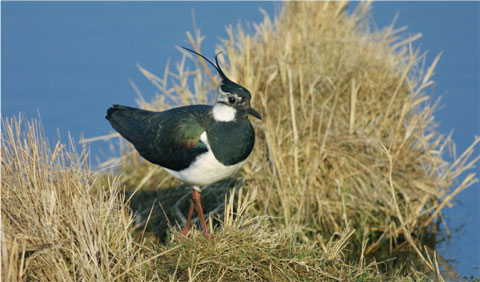
12 POPULATIONS OF WILD FAUNA IN THE OPEN COUNTRYSIDE
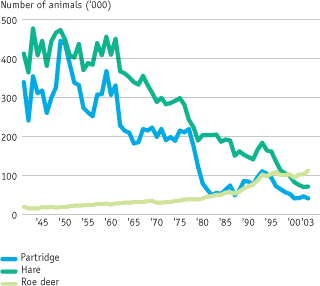
Source: National Environmental Research Institute (NERI)
The graph shows hunting bags of hare, partridge, and roe deer from 1941 to 2003 and serves as an indicator for the development trends for the population of these species in the open countryside.
There have been significant changes for some game on agricultural land over the past 50 years. A considerable increase in bags of roe deer, and corresponding falls in bags of hare and partridge reflects great changes in populations. The population of roe deer has increased because the deer have had perfect breeding conditions over a long period, with access to plentiful food in forests and on cultivated fields. At the same time the climate has been favourable, and since the 1980s, fawns have been less threatened by foxes because of outbreaks of fox scabies in Jutland and on Bornholm. In contrast to the roe deer, populations of hare and partridge have fallen dramatically since 1960. These two species are more dependent on open country than the roe deer, which uses both forests and fields. The reason for the fall in the numbers of hare and partridge can primarily be found in changes in agricultural practices, for example increasing sizes of fields, and more uniform crops, both of which result in less food. With the relatively low numbers, it is also likely that hare and partridge have become more vulnerable to predators such as foxes, crows, and magpies.
One of the goals in the Government's Action Plan for Biodiversity and Nature Conservation in Denmark 2004-2009 is to protect the natural habitats of vulnerable species and stop the deterioration in biological diversity before 2010.
13 BUTTERFLIES
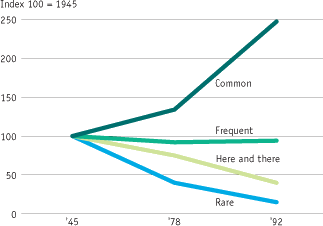
Source: Danish Forest and Nature Agency
The graph shows the distribution of the 79 species of Danish butterfly. The species have been divided into four groups according to how common they were between 1900 and 1963. The most common quarter of species has increased since 1963, while the rarest species have declined.
The fall in the number of rare species is especially due to the disappearance of their habitats. In Denmark, two-thirds of butterflies live in meadows, marshes and dry grassland, and one-half of these species now appear on the Red List of threatened species. Nine species have disappeared over the past 50 years.
Since 1963, the most common butterflies such as the small cabbage white and the small tortoiseshell butterfly, which thrive on thistles and nettles, have increased at the expense of falling numbers of rare species such as the marsh fritillary and ilex hairstreak.
Registration of the number of plant and animal species on the Red List, compared with Danish natural habitats, could help target efforts to preserve and re-establish habitats for native Danish animals and plants with large sustainable populations both on land and in fresh-water and marine environments.

Otter population
The four maps show the occurrence and distribution in 10x10 UTM squares of otter from national monitoring in Denmark in 1984-1986, 1991, 1996, and 2004.
In collaboration with regional authorities, the National Environmental Research Institute in spring 2004 conducted a nation-wide monitoring survey of the otter population in Denmark. The survey was part of the new national nature and aquatic-environment monitoring programme, NOVANA. Nation-wide monitoring surveys of Danish otters were previously carried out in 1984-1986, 1991 and 1996, which provides ample opportunity for comparing the population development over a 20-year period.
Results show that the otter has increased considerably in numbers in Denmark since the mid 1980s. In the mid 1980s, not many otters were observed except in the northern and northwestern parts of Jutland (Ringkjøbing, the counties of North Jutland and Viborg). However, today the population of otter has increased in Aarhus County and the otter is once more present in the counties of Vejle, Ribe, and Southern Jutland where otters can be found near the border to Germany. In West Zealand, where the otter was considered to have disappeared until it was seen again in 1996, two new spottings have confirmed its continued presence in this region.
The positive development in the population of otter can be explained e.g. by targeted conservation efforts in the form of a management plan in 1996 and, later, in connection with the implementation of the EU Habitats Directive. Requirements for preventive grids in fishing nets and the establishment of fauna corridors under new and old roads has led to fewer numbers of otters drowning in fishing nets or being killed on the roads. At the same time, regional authorities are taking the otter into consideration in their management of the open countryside: more and more care is being taken to conserve the otters' natural habitats, establish new habitats through nature restoration, and designate corridors via which the otter can travel undisturbed from place to place.
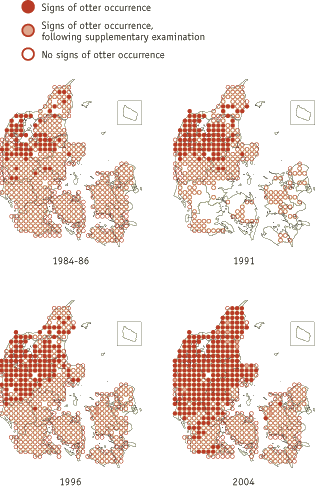
Source: National Environmental Research Institute, NERI
14 MONITORING ORCHIDS
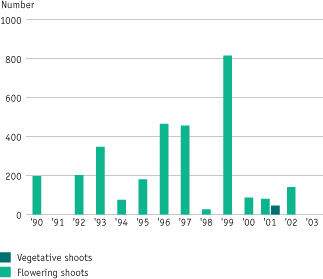
Source: National Environmental Research Institute (NERI), survey of orchids
The figure shows the conservation status for broad-leaved marsh orchid, exemplified via this orchid type's status at Almstofte, a location in the County of West Zealand. The Broad-leaved marsh orchid is found in about 800 locations throughout Denmark, making it the most common wild orchid in Denmark. Considered across all localities, the broad-leaved marsh orchid is in decline.
Monitoring of orchids and their habitats began in 1943 when the state forest district of Buderupholm in North Jutland commenced a count of the region's population of lady's slipper orchids (Cypripedium Calceolus).
Monitoring of other species was commenced in 1982. Since then, all 46 Danish species of orchids in the wild have been monitored for shorter or longer periods of time. Of these, 21, or 46 per cent, are on Denmark's Red List of threatened species. This means that they have either disappeared (3 orchids), or that they are critically endangered (3 orchids), moderately endangered (8 orchids), or vulnerable (7 orchids).
The most common species throughout Denmark are monitored in selected locations, whereas the species that are only common in 10 locations or fewer throughout Denmark are monitored, more or less, in all locations where they are found.
The orchid as a species is protected, which means that the plant may not be damaged or up-rooted; nor may its seeds be collected. Orchids may, however, be enjoyed in nature. Some orchid species place high demands on their habitat and lead a complicated co-existence with certain fungi. Other species can live in various places and are common in most regions of Denmark.
15 SEALS
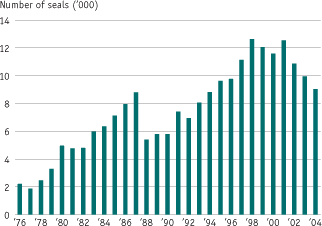
Source: National Environmental Research Institute (NERI)
The graph shows the number of common seal in Danish waters counted from aeroplanes during the period 1976-2004. The figures have been corrected for seals underwater during the count. In some years the population of seal was not counted in all marine areas but estimated or calculated as averages based on figures for the previous and subsequent years.
There are two species of seal permanently resident in Danish waters, the common seal, and the grey seal. The grey seal became protected by statute in 1967, and it is still very rare in Denmark (<50 animals per year). In February 2003, two grey seal young were observed at Rødsand near Gedser. This shows us that the grey seal has begun to breed in Denmark for the first time for more than hundred years.
In 1976, the common seal was protected by statute. After being protected, the population of common seal grew by about 12 per cent per year. In spring 1988, the common seal was hit by the worst mass mortality of sea mammals ever recorded in European waters. Over 18,000 seals were found dead along the northern European coastline (the Netherlands to north Norway), and about 60 per cent of the Danish population died. In 2002, all populations of Danish seal were again hit by the deadly seal virus (PDV) that hit in 1988, and about 45 per cent of the Danish population is thought to have died. In autumn 2004, more than 9,000 common seals and 31 grey seals were observed in Danish waters.
In 2005 the Ministry of the Environment published a management plan for the common seal and the grey seal in Denmark. The objective of the plan is to give the seals the best possible living conditions and to ensure their protection and survival. The plan is also to help implement the Habitats Directive target of ensuring or restoring the favourable conservation status for seals.
16 CATCHES OF FISH IN DANISH WATERS
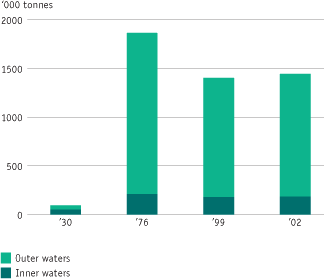
Source: National Environmental Research Institute (NERI)
The bars show Danish catches broken down between those from inner and outer waters in 1930, 1976, 1999, and 2002.
Many commercial fish in Danish waters are being exploited so intensively that half the stock is fished each year. In 2001, the International Council for the Exploration of the Sea (ICES) described a major part of commercial stocks as overfished. This includes cod, plaice, sole, haddock, whiting, pollack, anglerfish, and eel. Catches by Danish fishermen have been in decline since the mid 1970s. Despite this, Danish waters cover some of the world's most important fishing grounds with annual landings from the North Sea, the Skaggerak, Kattegat, and the Baltic Sea of 3.5 million tonnes. Of this amount, Danish fishermen caught 1.5 million tonnes per year in the late 1990s. In recent years, fishing has become more efficient, with fewer and larger vessels.
In 2001, the Danish Parliament adopted some key objectives for the development of a national fisheries policy in the years to come. One objective calls for the modernisation, renewal, and simultaneous reduction of the fisheries fleet. The objective is to ensure long-term, stable and sustainable fisheries in relation to possible catches and continued local fisheries with a wide geographical basis. Within this framework, the national management of fisheries quotas will be adapted. Goals include to develop coastal fishing and to promote the quality of landings.
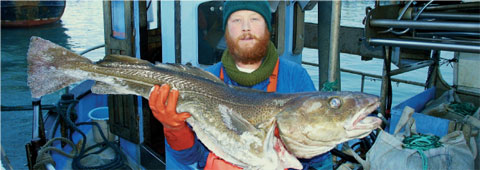
17 INTRODUCED SPECIES AND THEIR DISTRIBUTION
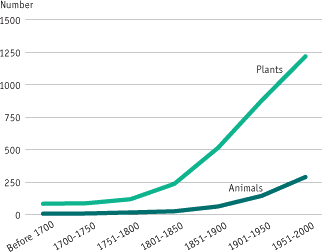
Source: Danish Forest and Nature Agency, and National Environmental Research Institute (NERI)
Plant and animal species that are brought to Denmark, either intentionally or unintentionally are called introduced species. Some of these introduced species may survive in Danish nature and a few are capable of procreating and spreading to a degree that they out-compete or otherwise threaten indigenous species; these are called invasive species. Examples of invasive species in Denmark are giant hogweed, mink, and killer slug (Iberian black slug).
The graph shows the number of animals and plants introduced to Denmark and subsequently found in nature. The species are broken down by time intervals of 50 years length, except, however, the category ”before 1700”. The total number of introduced species in the present statement is more than 2,570. For 1,534 of the species, we know the time of introduction (presented in the figure). About 600 species have adapted to the Danish environment, i.e. become naturalised. For animals, the annual introduction rate has increased in the most recent time interval, whereas the introduction rate for plants appears to be relatively constant. About four-times more plants than animals have been introduced.
The majority of introduced species cause no or few problems, however a few have spread with great speed and threaten to out-compete other species. These invasive species pose
a problem in nature, which is gaining ever more attention. They invade natural areas, gardens, and parks, they may spread diseases, and combating them is a costly and difficult affair. Ground elder, wild
oat-grass, and brown rat are examples of invasive species, which we are spending many resource combating.
The problem has been recognised internationally as extensive and as a global threat against biodiversity surpassed only by the destruction of natural habitats. Therefore, the UN Convention of Biological Diversity contains a common international commitment to limit the introduction and negative effects of invasive species.
Intended introduction also includes species that are introduced in a new country as e.g. ornamental plants or pets, and which then are spread or escape and establish themselves in nature. The intended introduction of huntable or fishable species also contributes to introduction of new species in the wild in Denmark. Non-indigenous animals may not be released into nature without permission, whether pets (such as turtles) or fish and animals for use in hunting or as part of nature management efforts. Unintended introduction is e.g. when a species is carried to Denmark as a stowaway along with goods, attached e.g. to cars, trains, or clothes, in which way they spread quickly across borders and continents.
With regard to the marine environment, ballast water, algal and marine growth on ships, and aquaculture activities, i.e. farming of freshwater or saltwater fish, are the most prevalent introduction routes for new species. Ships' ballast water may even serve to introduce species that survive in freshwaters.
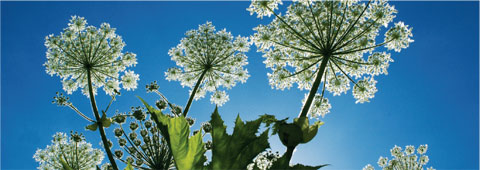
Version 1.0 December 2005, © Danish Environmental Protection Agency